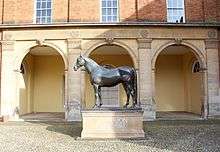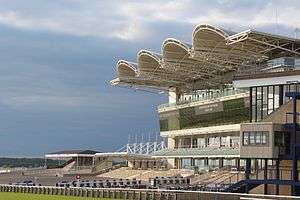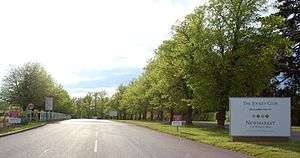Jockey Club
The Jockey Club is the largest commercial horse racing organisation in the United Kingdom. No longer responsible for the governance and regulation of British horseracing, today it owns 15 of Britain's famous racecourses, including Aintree, Cheltenham, Epsom Downs and both the Rowley Mile and July Course in Newmarket, amongst other concerns such as the National Stud, and the property and land management company, Jockey Club Estates. The registered charity Racing Welfare is also a company limited by guarantee with the Jockey Club being the sole member. As it is governed by Royal Charter, all profits it makes are reinvested back into the sport.
 The Jockey Club Rooms in Newmarket, UK | |
| Private incorporated by Royal Charter | |
| Industry | Horse racing, Leisure |
| Founded | 1750 |
| Headquarters | |
Area served | United Kingdom |
Key people | Sandy Dudgeon (Senior Steward), Delia Bushell (CEO) |
| Revenue | £214.6m (2018) |
Number of employees | circa 650 FTE |
| Divisions | Jockey Club Racecourses, Jockey Club Estates, The National Stud, Racing Welfare, Jockey Club Catering, Jockey Club Live, Jockey Club Services |
| Website | thejockeyclub |



Formerly the regulator for the sport, the Jockey Club's responsibilities were transferred to the Horseracing Regulatory Authority (now the British Horseracing Authority) in 2006.
History
The Jockey Club has long been thought to have been founded in 1750 – a year recognised by the club itself in its own records. Some claim it was created earlier, in the 1720s,[1] while others suggest it may have existed in the first decade of the century.[2]
It was founded as one of the most exclusive high society social clubs in the United Kingdom, sharing some of the functions of a gentleman's club such as high-level socialising. It was called 'The Jockey Club' in reference to the late medieval word for 'horsemen', pronounced 'yachey', and spelt 'Eachaidhe' in Gaelic.[3] The club's first meetings were held at the "Star and Garter" tavern in Pall Mall, London, before later moving to Newmarket;[4] a town known in the United Kingdom as "The Home of Racing". It was historically the dominant organisation in British horseracing, and it remained responsible for its day-to-day regulation until April 2006.
It passed its first resolution in 1758, that all riders must weigh in after a race.[5]
In the late 19th and early 20th centuries, The Jockey Club had a clubhouse in Pall Mall, where many other gentlemen's clubs were based. The fact that it acquired a governing role in the sport reflected the dominant role of the aristocracy in British horse racing up to the 20th century, and the removal of this role was in part a conscious effect to move the sport away from its patrician image. This can be compared with the way that cricket's Marylebone Cricket Club became the governing body of cricket by default, but later surrendered most of its powers to more representative bodies.
The Jockey Club did not allow women to train horses under licence until 1966, when it was taken to court by trainer Florence Nagle. Prior to that women trainers such as Helen Johnson Houghton had to operate under a licence in a man's name. The Jockey Club did not allow women to ride under its rules until 1972. That year Meriel Tufnell became the first woman to partner a winning horse.
The new system
Before 2006, it was one of the three bodies which provided management for horse racing in the United Kingdom in conjunction with the British Horseracing Board (itself an offshoot of The Jockey Club) and the Horserace Betting Levy Board.
These regulatory responsibilities were transferred to a new Horseracing Regulatory Authority (HRA) from 3 April 2006.[6] This major re-organisation did not arise from a fundamental failure of the existing arrangements, but an understanding that the old system might not meet modern conditions. The HRA itself ceased to exist on 31 July 2007 as its regulatory duties were merged with the governing responsibility of the British Horseracing Board to create the new British Horseracing Authority.
Governance
The Jockey Club is run by executives who report to the Board of Stewards (directors). The chairman of the board is called the Senior Steward. As of December 2017 there were seven Stewards, including the Senior Steward and Deputy Senior Steward.[7] Individuals may be elected as Members, who "are in effect 'trustees'. However, they may not profit from their role, as all profits are invested into British racing." As of December 2017 there were 162 Members, including 24 Honorary Members.[8]
Property
- Jockey Club Racecourses: operates 15 racecourses in Great Britain, which host a quarter of the racing calendar. This includes four of the five 'Classics' of Flat racing: The Oaks and The Derby at Epsom Downs and the 2,000 Guineas and the 1,000 Guineas at Newmarket's Rowley Mile course, and major National Hunt meetings include the Cheltenham Festival and the Grand National at Aintree
- Jockey Club Estates: property and land management company, which operates 3,000 acres of training facilities in Newmarket and Lambourn
- The National Stud: a breeding and bloodstock training operation transferred to the Jockey Club in 2008
- Racing Welfare: a racing charity that aims to help to those working in the Thoroughbred industry[9]
- Racing Calendar, publication
Racecourse ownership
Jockey Club Racecourses was formerly called Racecourse Holdings Trust. The fifteen racecourses owned by Jockey Club Racecourses are:
Large courses:
- Aintree – Merseyside
- Cheltenham – Gloucestershire
- Epsom – Surrey
- Haydock Park – Merseyside
- Kempton Park – Surrey
- Newmarket July Course – Cambridgeshire
- Newmarket Rowley Mile – Suffolk
- Sandown Park – Surrey
Smaller courses:
- Carlisle – Cumbria
- Exeter – Devon
- Huntingdon – Cambridgeshire
- Market Rasen – Lincolnshire
- Nottingham – Nottinghamshire
- Warwick – Warwick
- Wincanton – Somerset
References
- Richard Nash, "Sporting with Kings," in Rebecca Cassidy (ed.), The Cambridge Companion to Horseracing (Cambridge University Press, 2013; ISBN 1107013852), p. 21.
- Donald W. Nichol, "Lost Trousers," The Times Literary Supplement, 26 July 2013, pp. 14-15, citing the frontispiece of a 1709 pamphlet called The History of the London Clubs.
- Dineen's Irish-English Dictionary, 1975, page 383
- "Our Heritage". The Jockey Club. Retrieved 2 January 2018.
- Barrett, Norman, ed. (1995). The Daily Telegraph Chronicle of Horse Racing. Enfield, Middlesex: Guinness Publishing. p. 9.
- Wood, Greg (3 April 2006). "End of an era as Jockey Club falls on own sword". The Guardian. Archived from the original on 31 August 2006. Retrieved 17 April 2006.
- "Our Board". The Jockey Club.
- "Our Members". The Jockey Club.
- http://www.tjcannualreview.co.uk/assets/Files/TJC_AR_Online_2013.pdf%5B%5D